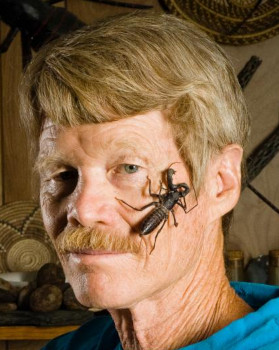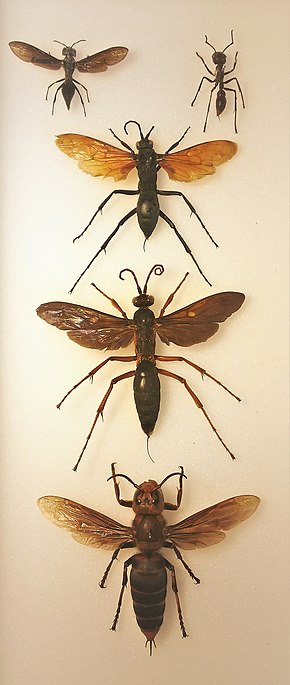While observers can easily confuse common wasps and bees at a distance or without close observation, there are many different characteristics of large bees and wasps that can be used to identify them.

The Mutillidae are a family of more than 7,000 species of wasps whose wingless females resemble large, hairy ants. Their common name velvet ant refers to their resemblance to an ant, and their dense pile of hair, which most often is bright scarlet or orange, but may also be black, white, silver, or gold. Their bright colors serve as aposematic signals. They are known for their extremely painful stings,, and has resulted in the common name "cow killer" or "cow ant" being applied to the species Dasymutilla occidentalis. However, mutillids are not aggressive and sting only in defense. In addition, the actual toxicity of their venom is much lower than that of honey bees or harvester ants. Unlike true ants, they are solitary, and lack complex social systems.

Paraponera clavata, commonly known as the bullet ant, is a species of ant named for its extremely painful sting. It inhabits humid lowland rainforests in Central and South America.

Paper wasps are vespid wasps and typically refers to members of the vespid subfamily Polistinae, though it often colloquially includes members of the subfamilies Vespinae and Stenogastrinae, discussed elsewhere, which also make nests out of paper. Paper wasp nests are characterized by open combs with down pointing cells. Some types of paper wasps are also sometimes called umbrella wasps, due to the distinctive design of their nests.

A tarantula hawk is a spider wasp (Pompilidae) that preys on tarantulas. Tarantula hawks belong to any of the many species in the genera Pepsis and Hemipepsis. They are one of the largest parasitoid wasps, using their sting to paralyze their prey before dragging it to a brood nest as living food; a single egg is laid on the prey, hatching to a larva which eats the still-living host. They are found on all continents other than Europe and Antarctica.

Wasps in the family Pompilidae are commonly called spider wasps, spider-hunting wasps, or pompilid wasps. The family is cosmopolitan, with some 5,000 species in six subfamilies. Nearly all species are solitary, and most capture and paralyze prey, though members of the subfamily Ceropalinae are kleptoparasites of other pompilids, or ectoparasitoids of living spiders.

A stinger is a sharp organ found in various animals capable of injecting venom, usually by piercing the epidermis of another animal.

A bee sting is the wound and pain caused by the stinger of a female bee puncturing skin. Bee stings differ from insect bites, with the venom of stinging insects having considerable chemical variation. The reaction of a person to a bee sting may vary according to the bee species. While bee stinger venom is slightly acidic and causes only mild pain in most people, allergic reactions may occur in people with allergies to venom components.

Poneratoxin is a paralyzing neurotoxic peptide made by the bullet ant Paraponera clavata. It prevents inactivation of voltage gated sodium channels and therefore blocks synaptic transmission in the central nervous system. Specifically, poneratoxin acts on voltage gated sodium channels in skeletal muscle fibers, causing paralysis, and nociceptive fibers, causing pain. It is rated as a 4 plus on the Schmidt sting pain index, the highest possible rating with that system, and its effects can cause waves of pain up to twelve hours after a single sting. It is additionally being studied for its uses in biological insecticides.
The Starr sting pain scale was created by the entomologist Christopher Starr as a scale to compare the overall pain of hymenopteran stings on a four-point scale, an expansion of the "pain index" originally created by Justin Schmidt. 1 is the lowest pain rating; 4 is the highest.

Justin Orvel Schmidt was an American entomologist, co-author of Insect Defenses: Adaptive Mechanisms and Strategies of Prey and Predators, author of The Sting of the Wild, and creator of the Schmidt sting pain index. Schmidt studied honey bee nutrition, chemical communication, physiology, ecology and behavior at the Carl Hayden Bee Research Center in Tucson, Arizona, before taking lead and devoting full-time to The Southwestern Biological Institute in 2006. As research director of the Southwest Biological Institute, he studied the chemical and behavioral defenses of ants, wasps, and arachnids.

Dasymutilla is a wasp genus belonging to the family Mutillidae. Their larvae are external parasites to various types of ground-nesting Hymenoptera. Members of this genus are highly variable in sting intensity, ranging from a 1 (D. thetis) to a 3 in the Schmidt sting pain index.
Pompilidotoxins (PMTXs) are toxic substances that can only be found in the venom of several solitary wasps. This kind of wasp uses their venom to offensively capture prey and is relatively harmless to humans. This is in stark contrast to social insects that defend themselves and their colonies with their venom.

A wasp is any insect of the narrow-waisted suborder Apocrita of the order Hymenoptera which is neither a bee nor an ant; this excludes the broad-waisted sawflies (Symphyta), which look somewhat like wasps, but are in a separate suborder. The wasps do not constitute a clade, a complete natural group with a single ancestor, as bees and ants are deeply nested within the wasps, having evolved from wasp ancestors. Wasps that are members of the clade Aculeata can sting their prey.

Many species of arthropods can bite or sting human beings. These bites and stings generally occur as a defense mechanism or during normal arthropod feeding. While most cases cause self-limited irritation, medically relevant complications include envenomation, allergic reactions, and transmission of vector-borne diseases.

Monobia quadridens, also known as the four-toothed mason wasp, is a species of solitary potter wasp found in North America. It grows to a wingspan of 18 mm (0.71 in), and feeds on small caterpillars and pollen. Two generations occur per year, with one generation overwintering as pupae.

Dasymutilla occidentalis is a species of parasitoid wasp that can be found worldwide but are native to North America. It is commonly mistaken for a member of the true ant family, as the female is wingless. The species ranges from Connecticut to Kansas in the north and Florida to Texas in the south. These insects live in environments such as pastures, meadows, fields, and forest edges, in warm and dry climates. They cohabitate with ground nesting bees and wasps. Adults are mostly seen in the summer months.

Synoeca is a genus of eusocial paper wasps found in the tropical forests of the Americas. Commonly known as warrior wasps or drumming wasps, they are known for their aggressive behavior, a threat display consisting of multiple insects guarding a nest beating their wings in a synchronized fashion, and an extremely painful sting. The sting is barbed and if used often kills the wasp, which may be the reason why such a striking defensive display is used. This display escalates from drumming inside the nest to hundreds of wasps moving on to the envelope of the nest and continuing to drum. If this does not deter the threat only then do the wasps begin to sting.

Hemipepsis ustulata is a species of tarantula hawk wasp native to the Southwestern United States. Tarantula hawks are a large, conspicuous family of long-legged wasps that prey on tarantulas by using their long legs to grapple with their prey and then paralyze them with a powerful sting. They are solitary, displaying lekking territorial behavior in their mating rituals.

Pepsis grossa is a very large species of pepsine spider wasp from the southern part of North America, south to northern South America. It preys on tarantula spiders, giving rise to the name tarantula hawk for the wasps in the genus Pepsis and the related Hemipepsis. Only the females hunt, so only they are capable of delivering a sting, which is considered the second most painful of any insect sting; scoring 4.0 on the Schmidt sting pain index compared to the bullet ant's 4.0+. It is the state insect of New Mexico. The colour morphs are the xanthic orange-winged form and the melanic black winged form. In northern South America, a third form, known as "lygamorphic", has a dark base to the wings which have dark amber median patches and a pale tip.
















